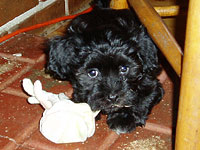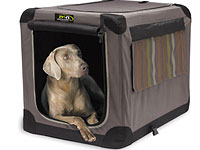 We started camping with the family pet last summer, when the kids got a Fire Bellied Toad for one of their birthdays. While Fire Bellied Toads are about as easy as it gets, when it comes to pets and camping, we finally bowed to a relentless onslaught of kid-induced pressure and are adding a puppy to the family next week.
We started camping with the family pet last summer, when the kids got a Fire Bellied Toad for one of their birthdays. While Fire Bellied Toads are about as easy as it gets, when it comes to pets and camping, we finally bowed to a relentless onslaught of kid-induced pressure and are adding a puppy to the family next week.
Hitting the backcountry with a dog is an entirely different situation and carries with it a completely new set of responsibilities. For one thing, getting a puppy has scrubbed one of our camping trips that we had planned for the first weekend in May. We found out that taking puppies under 16 to 20 weeks into an environment like a campground is dangerous, due to parvovirus.
Once the puppy is old enough for camping, though, we will have to figure out the best way to do that. Our current plan is to take a crate for the dog to sleep in, but there are a lot of other issues, too. For one thing, we will no long be able to just take-off on a hike, without taking the dog with us of course. That means a leash and a water bowl, and probably some other items that I haven’t even considered yet. All of a sudden, “hiking†is sounding a lot more like walking the dog, than hiking.
The kids are going to love camping with a dog, though, so I guess a few sacrifices are worth the effort if it keeps them interested in the outdoors. I have a feeling that the kids are going to learn some valuable life-long lessons about responsibility and work ethic out of this, because I’m sure not doing all the work!
See also…


We always take our golden retriever with us camping; it wouldn’t be the same without him! We make sure to take his bed, food & water dishes from home. We have a long plastic coated metal run that we can hook to a tree or whatever (but he usually just “hangs out” with us). We always make sure to put his water at the very edge of where he can reach when he’s on his run, or he ends up tipping it over…we also usually buy a few big rawhides for him to work on when we have to leave him at our campsite unattended (some campgrounds don’t allow this, so be careful!). We also make sure to take his brush, cause he always ends up with little sticks and stuff stuck in his fur and it’s much easier to brush it out everyday, rather than wait till you get home and have a tangled mess to brush out! Also, if you are camping anywhere near rivers, make sure your dog doesn’t get into any dead fish on the shores; can make your dog really sick…
When I was a teenager, I almost lost my Border Collie to salmon poisoning. We camped with some friends, on this last trip, who had a Golden Retriever – she was a lot of fun and sure loved the water!
Thanks Dan – I’ve had a couple of border collies, since I was a kids. Great dogs!
One thing for sure, my border collie would be aggravated at the end of a leash all day. The suggestions for a tie off are definitely good. But infallible obedience is the real liberator. It took about 1.5 years for my dog to meet my standard of independence and training, which is equally rewarding at home and on the trails.
I’ve seen a doggy tent (via REI I believe), but my dog just sleeps at the foot of the tent without any incident (careful that nails are well-groomed, of course). A tarp and crate would work for a car camp. I have a pack harness and booties so the dog can haul some of his own baggage. I use the booties with good success when I bike with him, too.
A current tag is a very good idea, as are location implants. But for the few dollars it takes, if you knew your camping plot in advance, for example, having a “traveling” tag, in addition to the one which may work back home, is a worthwhile investment. Reflective collar and/or strobing tags are good for spotting your dog at night. (You’re probably correctly getting the impression by now my dog just “hangs out”–I control him with dedicated training, not restraints).
Balls, Frisbee, and treats are good to pack, too. Extra towel for damp dog, food in multiple Ziplocs (so one failure doesn’t compromise the entire supply)…that’s about all I can think of for now.
Best of luck! I’m sure the whole family will really enjoy having a new member.
Dan’s last blog post..How To: Make Your Own Tinder
My recommendation – bypass the national parks and head for national forest trails – dogs are always welcomed. Two tips – watch for heat stroke (hiking in a fur coat is hot work). If you think your pup is overheating, take a break in a shady spot. Wet the underside of its ears, belly and/or paws – almost immediate cool down. And bring pup’s shot records and your vet’s phone number, just in case. In fifteen years we need this information only once but it was super important to saving our dog life.
Karen makes several excellent points.
I think it’s especially important to train your dog well. That way it will behave and obey you all the time. You especially don’t want a barker.
And although I didn’t do it with my dogs, and I wish I had, it’s very useful to train your dog to sleep in its crate. It becomes the dog’s den and they love it, and you always have a place to put them where they are happy.
My sweetheart Stephanie and I are considering getting a cockapoo puppy. I’m not sure how my nearly 13-year old golden retriever Molly feels about that.
John Soares’s last blog post..The 11 Crucial Factors That Determine Your College Textbook Supplements Writing Income
Hi Roy,
We go camping with our dog all the time. She’s a small Chihuahua, but she can hike 10 miles a day. 🙂 We started her out early, 4 months, so she would be comfortable around a campfire and sleeping in a tent. We bring her dog bed from home so she has something familiar. We also bring the collapsible/folding water and food bowls to save space, plus they can be carried in a pocket or backpack while hiking. That allows her to share our water out of her own bowl.
The only bummer about camping with a dog is the fact that many times dogs are not allowed on hiking trails in national parks. So you may have some restrictions that way, but the joy of camping with a dog far outweighs the limits.
The leash anchors are definately the way to go. If your puppy goes hiking with you, he should be worn out at night and sleep well. Our dog is, thankfully, not a yapper. Which comes in handy when out hiking and we stumble on a bear. I’d hate to see what would happen if she did start to bark – ugh.
We make sure to check her for tics, but she is also on Sentinel, which is a medication for flea and tic prevention I highly recommend.
Sedona loves to camp as I’m sure your new puppy will as well. All we have to tell her is “let’s go camping” and she’s at the door ready to go.
Well, sorry to be so long winded, but those are a few of the tips I can offer.
Have a great trip with the new addition to the family! 🙂
Thanks Mike – ran over to Petco during lunch yesterday and saw those leash anchors (they do look strong enough for the kids – hmmm…).
I don’t have a lot of tips to offer, but definitely bring one of those screw-in leash anchors. Then leash the dog far enough out so that it isn’t always getting tangled in chairs and picnic tables. And (common sense) put its food and water just at the limit of the leash so they don’t constantly knock that over. Hmmm… come to think of it, this arrangement might work for the kids, too 🙂 Hopefully your dog will grow to love hiking the way ours has… it may just end up pulling you up the hill!
Mike Hahn’s last blog post..The day the music died…